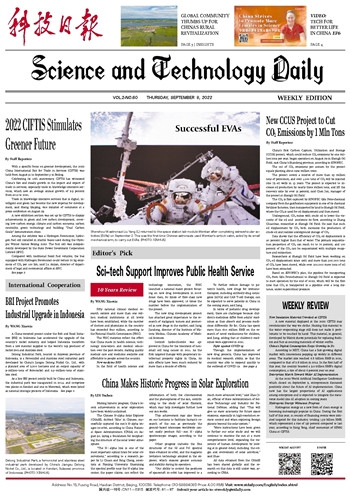
 Academic Journey to Roof of the World
Academic Journey to Roof of the World Global Community Thumbs up for China's Rural Revitalization
Global Community Thumbs up for China's Rural Revitalization 2022 CIFTIS Stimulates Greener Future
2022 CIFTIS Stimulates Greener Future New CCUS Project to Cut CO_2 Emissions by 1 Mln Tons
New CCUS Project to Cut CO_2 Emissions by 1 Mln Tons Sci-tech Support Improves Public Health Service
Sci-tech Support Improves Public Health Service BRI Project Promotes Industrial Upgrade in Indonesia
BRI Project Promotes Industrial Upgrade in Indonesia WEEKLY REVIEW
WEEKLY REVIEW China Makes Historic Progress in Solar Exploration
China Makes Historic Progress in Solar Exploration WECHAT ACCOUNT
WECHAT ACCOUNT E-PAPER
E-PAPER
 |
| Shenzhou-14 astronaut Liu Yang (L) returned to the space station lab module Wentian after completing extravehicular activities (EVAs) on September 2. This was the first time Chinese astronauts used Wentian's airlock cabin, aided by its small mechanical arm, to carry out EVAs. (PHOTO: XINHUA) |
Fifty national clinical medical research centers and more than one million medical institutions at all levels have been established, while the number of doctors and physicians in the country has exceeded four million, according to the National Health Commission (NHC).
The NHC statistics reflect the effort that China made in health science, technology innovation and medical education over the past decade, making quality medical care and medicine available and affordable to people across the country.
New medicine R&D
In the field of health science and technology innovation, the NHC launched a national major project focusing on new drug development in 2008. Since then, 80 kinds of first-class new drugs have been approved, 16 times the number before the implementation of the project.
The new drug development project has attached great importance to the research of malignant tumors and promoted 31 new drugs in the market, said Jiang Jiandong, director of the Institute of Materia Medica, Chinese Academy of Medical Sciences.
Icotinib hydrochloride was approved in China for the treatment of non-small cell lung cancer in 2011. As the first targeted therapy with proprietary intellectual property rights in China, its side effects have been much reduced by more than a decade of efforts.
To further reduce damage to patient's health, new drugs for immunotherapies, including antibody-drug conjugates (ADCs) and CAR T-cell therapy, can be expected to serve patients in China in the coming years, said Jiang.
In terms of pediatric drug development, there are challenges because children's medicines differ from adults' medicines as they absorb and process medicines differently. By far, China has spent more than 600 million RMB on the research of novel medications for children, said Jiang, adding that 47 children's medicines were approved in 2021.
Fight against COVID-19
Through the implementation of new drug projects, China has improved its medical research ability, so that the country was able to respond quickly to the outbreak of COVID-19.
Chinese researchers determined and isolated the novel coronavirus, conducted gene sequencing of the virus, and shared results with the world, said Liu Dengfeng, an NHC official.
Preliminary identification of a novel virus in a short period of time is a notable achievement and demonstrates China's increased capacity to manage new outbreaks, said the World Health Organization (WHO).
China rapidly developed the novel coronavirus nucleic acid detection technology with high sensitivity and specificity, which played a crucial role in early diagnosis and screening of positive coronavirus infections.
In terms of vaccines, three Chinese-developed COVID-19 vaccines were approved for emergency use by the WHO, and realized large -scale production of up to billions of doses.
In addition, the country's first COVID-19 antibody cocktail therapy was approved by China's National Medical Products Administration (NMPA) in October, 2021.
More inclusion
To ensure people's equal access to quality medical services, China has carried out medical assistance programs to improve public health in the less-developed inland areas.
Medical assistance has helped Xizang Autonomous Region and Xinjiang Uygur Autonomous Region boost their healthcare sectors.
Over the past seven years, more than 2,500 medical professionals from top hospitals across China have been dispatched to Xizang and Xinjiang every year to provide assistance to local medical institutions, and trained more than 5,800 local medical professionals, said Li Dachuan, deputy head of medical administration and supervision at the NHC.
As local medical treatment and public health conditions have been continuously improved, tangible benefits were brought to local residents. By the end of 2020, the average life expectancy in Xiang had increased to 72.19 years, compared with 68.2 years in 2018, said the NHC. Over the past three years, maternal and infant mortality rates in the region have also decreased by 19.5 percent and 35.3 percent respectively.
Meanwhile in Xinjiang, several departments have been established or upgraded in eight assisted hospitals. A total of 332 kinds of acute and critical diseases can now be treated in Xinjiang and 1,914 common diseases can be treated in the prefectures.

 Next
Next



